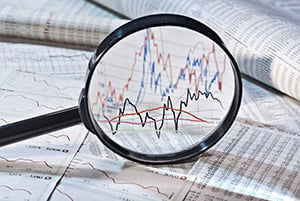 After a brief recovery, it looks like the market decline may have resumed. Although we never quite got to the 20 percent bear market threshold for the S&P 500 in the previous decline, it now looks like we are headed down again, so we might well get there. Once we get to an official bear market, the question then becomes how much lower we might go. Indeed, those are the top questions I am getting right now: how bad can this get—and when will it be over?
After a brief recovery, it looks like the market decline may have resumed. Although we never quite got to the 20 percent bear market threshold for the S&P 500 in the previous decline, it now looks like we are headed down again, so we might well get there. Once we get to an official bear market, the question then becomes how much lower we might go. Indeed, those are the top questions I am getting right now: how bad can this get—and when will it be over?
I don’t know the answer to those questions (and neither does anyone else). What I do know, however, is that interest rates are what we need to watch, because they are what will determine the answers.
Why Interest Rates?
There are two reasons we need to keep an eye on rates. First, interest rates determine how much stocks are worth. Lower rates mean higher valuations for stocks, which explains the market rally we saw during and after the pandemic, as rates were cut to zero and stocks soared. With rates rising again as the Fed tightens policy, we are seeing valuations adjust down, bringing down the market.
Second, beyond the direct effect on stock valuations, higher interest rates slow economic activity and hurt earnings. We are already seeing this in many sectors, especially housing, and the slowdown will become more apparent the higher rates go. With slower earnings growth combined with lower valuations, higher rates are a double whammy for the market—as we are seeing. When rates rise quickly, the market falls quickly, which explains the year so far. It also gives us the context to answer the question of how deep and long-lasting the decline will be.
So, What Should We Watch?
To do so, though, we have to determine which interest rates are the best indicators to watch. I use the U.S. Treasury 10-year note. Stocks are long-duration assets, which makes them a good indicator for valuation purposes. For economic purposes, they are a good proxy for long-duration loans such as mortgages or autos. While this should work in theory, it also works in practice. Over the past five years, changes in the 10-year yield have explained 60 percent of the change in stock valuations.
To understand whether we will get to a bear market—and how bad it will be—we need to look at interest rates. Recently, as rates stabilized a bit under 3 percent, I noted that the S&P 500 was approaching fair value at around 3,800. Indeed, we dropped to there and bounced. If rates stay around 3 percent, then that is likely the bottom of the range. But rates may not stay at that level, and they have moved back up above 3 percent to around a five-year high. If rates keep rising, then valuations will move lower and so will the market.
Looking at interest rate projections, the bond market as a whole expects the Fed’s rate increases to keep going to the second half of the year and then possibly pause. The 10-year yield will be influenced by that, although not entirely determined by it. It also incorporates the likely cuts in rates once the economy starts to slow. With signs of slowing apparent, that might be sooner than the market thinks. In any event, current expectations are that rate increases will continue for some time. Note, though, that those increases are currently priced into the longer-term rates, and those expectations are very hawkish.
Are Expectations Too Hawkish?
Those hawkish expectations may be overdone. With signs that inflation is rolling over and increasing speculation that the Fed may pause rate increases before year-end, the balance of risks is likely more toward less tightening than more tightening. That will likely keep long-term rates around 3 percent, as we have seen so far.
If that is the case, valuations are already close to the lows. Even if they pull back again, they may not reach the bear market threshold. Looking at interest rates, unless we do see a renewed increase in rates, the pullback is closer to the finish than to the start. As expectations moderate, stable or declining rates will move from a market headwind to a tailwind.
We may have a couple more months to go, in other words, especially given the weak summer seasonal market factors, but we are likely close to the end of the pullback. As valuations stabilize, rising earnings can start to push the market up again, and that will be an offsetting factor as well.
Don’t Fight the Fed
All of the above is perhaps only a long-winded way of saying an old market truism: don’t fight the Fed. And it is—but it is also an explanation of why that is true. In this case, that truism is encouraging.
Don’t watch the market, watch interest rates. When they start to drop again, the pullback will be over. And based on what we know so far? That could well happen this fall.


 Print
Print

